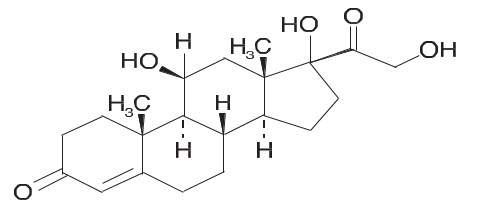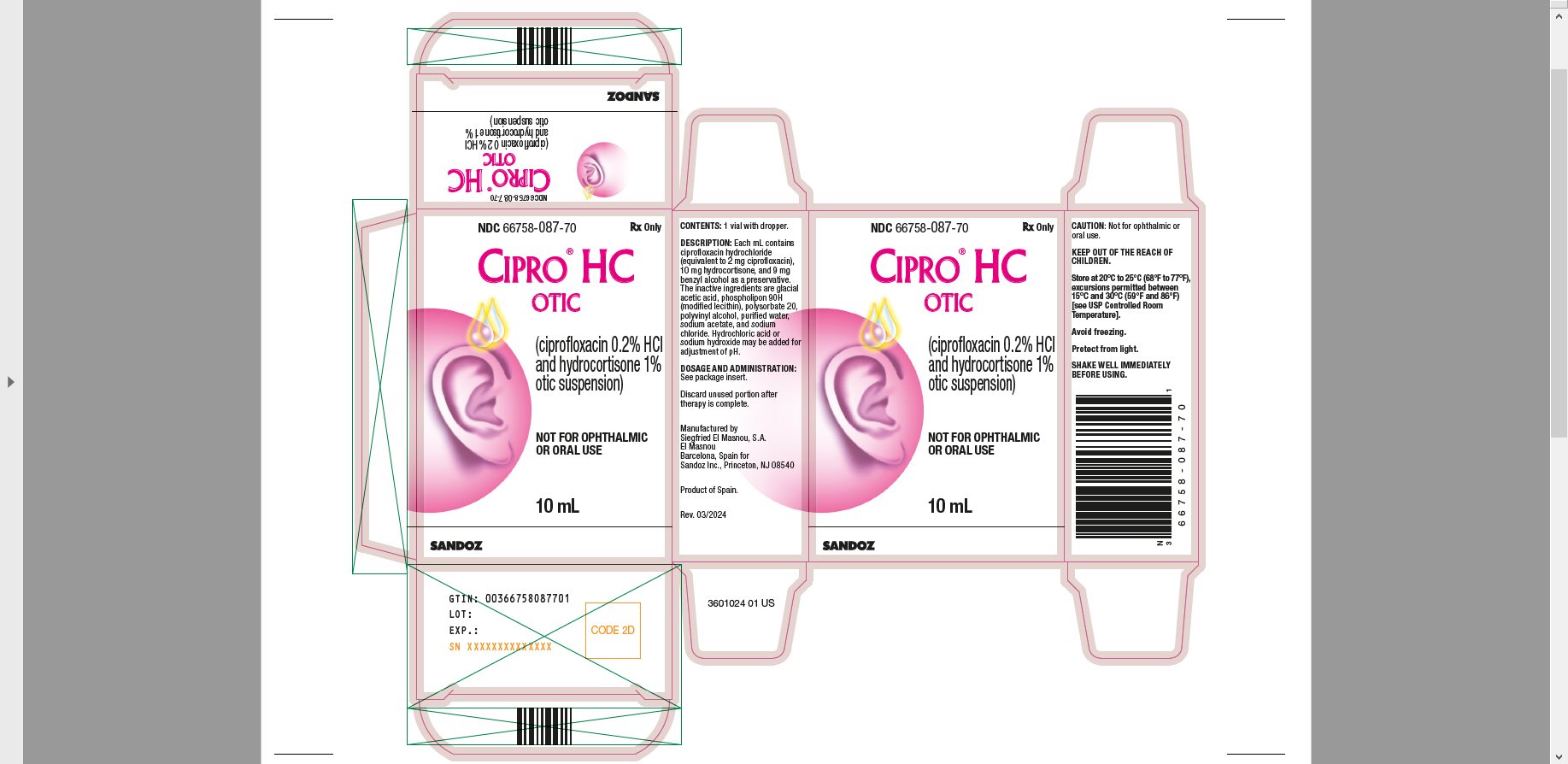Label: CIPRO HC- ciprofloxacin hydrochloride and hydrocortisone suspension/ drops
- NDC Code(s): 66758-087-70
- Packager: Sandoz Inc
- Category: HUMAN PRESCRIPTION DRUG LABEL
- DEA Schedule: None
- Marketing Status: New Drug Application
Drug Label Information
Updated November 8, 2024
If you are a consumer or patient please visit this version.
- Download DRUG LABEL INFO: PDF XML
- Official Label (Printer Friendly)
- Rx Only
-
DESCRIPTION
CIPRO® HC OTIC (ciprofloxacin hydrochloride and hydrocortisone otic suspension) contains the synthetic broad spectrum antibacterial agent, ciprofloxacin hydrochloride, combined with the anti-inflammatory corticosteroid, hydrocortisone, in a preserved, nonsterile suspension for otic use. Each mL of CIPRO® HC OTIC contains ciprofloxacin hydrochloride (equivalent to 2 mg ciprofloxacin), 10 mg hydrocortisone, and 9 mg benzyl alcohol as a preservative. The inactive ingredients are glacial acetic acid, phospholipon 90H (modified lecithin), polysorbate 20, polyvinyl alcohol, purified water, sodium acetate, and sodium chloride. Hydrochloric acid or sodium hydroxide may be added for adjustment of pH.
Ciprofloxacin, a fluoroquinolone, is available as the monohydrochloride monohydrate salt of 1-cyclopropyl-6-fluoro-1,4-dihydro-4-oxo-7-(1-piperazinyl)-3-quinolinecarboxylic acid. Its empirical formula is C17H18FN3O3•HCI•H2O and its chemical structure is as follows:
Hydrocortisone, pregn-4-ene-3, 20-dione, 11, 17, 21-trihydroxy-(11(β)-, is an anti-inflammatory corticosteroid. Its empirical formula is C21H30O5 and its chemical structure is:
-
CLINICAL PHARMACOLOGY
The plasma concentrations of ciprofloxacin were not measured following three drops of otic suspension administration because the systemic exposure to ciprofloxacin is expected to be below the limit of quantitation of the assay (0.05 μg/mL).
Similarly, the predicted Cmax of hydrocortisone is within the range of endogenous hydrocortisone concentration (0-150 ng/mL), and therefore cannot be differentiated from the endogenous cortisol.
Preclinical studies have shown that CIPRO® HC OTIC was not toxic to the guinea pig cochlea when administered intratympanically twice daily for 30 days and was only weakly irritating to rabbit skin upon repeated exposure.
Hydrocortisone has been added to aid in the resolution of the inflammatory response accompanying bacterial infection.
Microbiology
Ciprofloxacin has in vitro activity against a wide range of gram-positive and gram-negative microorganisms. The bactericidal action of ciprofloxacin results from interference with the enzyme, DNA gyrase, which is needed for the synthesis of bacterial DNA. Cross-resistance has been observed between ciprofloxacin and other fluoroquinolones. There is generally no cross-resistance between ciprofloxacin and other classes of antibacterial agents, such as beta-lactams or aminoglycosides.
Ciprofloxacin has been shown to be active against most strains of the following microorganisms, both in vitro and in clinical infections of acute otitis externa as described in the INDICATIONS AND USAGE section:
Aerobic Gram-positive Microorganism
Staphylococcus aureus
Aerobic Gram-negative Microorganisms
Proteus mirabilis
Pseudomonas aeruginosa
- INDICATIONS AND USAGE
-
CONTRAINDICATIONS
CIPRO® HC OTIC is contraindicated in persons with a history of hypersensitivity to hydrocortisone, ciprofloxacin, or any member of the quinolone class of antimicrobial agents. This nonsterile product should not be used if the tympanic membrane is known or suspected to be perforated. Use of this product is contraindicated in viral infections of the external canal, including varicella and herpes simplex infections.
-
WARNINGS
NOT FOR OPHTHALMIC USE. NOT FOR INJECTION.
CIPRO® HC OTIC should be discontinued at the first appearance of a skin rash or any other sign of hypersensitivity. Serious and occasionally fatal hypersensitivity (anaphylactic) reactions, some following the first dose, have been reported in patients receiving systemic quinolones. Serious acute hypersensitivity reactions may require immediate emergency treatment. The dropper cap contains natural rubber (latex) which may cause severe allergic reactions.
-
PRECAUTIONS
General:
As with other antibiotic preparations, use of this product may result in overgrowth of nonsusceptible organisms, including fungi. If the infection is not improved after one week of therapy, cultures should be obtained to guide further treatment.
Information for Patients:
If rash or allergic reaction occurs, discontinue use immediately and contact your physician.
Do not use in the eyes.
Avoid contaminating the dropper with material from the ear, fingers, or other sources.
Protect from light.
Shake well immediately before using.
Discard unused portion after therapy is completed.
Carcinogenesis, Mutagenesis, Impairment of Fertility:
Eight in vitro mutagenicity tests have been conducted with ciprofloxacin, and the test results are listed below:
Salmonella/Microsome Test (Negative)
E. coli DNA Repair Assay (Negative)
Mouse Lymphoma Cell Forward Mutation Assay (Positive)
Chinese Hamster V79 Cell HGPRT Test (Negative)
Syrian Hamster Embryo Cell Transformation Assay (Negative)
Saccharomyces cerevisiae Point Mutation Assay (Negative)
Saccharomyces cerevisiae Mitotic Crossover and Gene Conversion Assay (Negative)
Rat Hepatocyte DNA Repair Assay (Positive)
Thus, 2 of the 8 tests were positive, but results of the following 3 in vivo test systems gave negative results:
Rat Hepatocyte DNA Repair Assay
Micronucleus Test (Mice)
Dominant Lethal Test (Mice)
Long-term carcinogenicity studies in mice and rats have been completed for ciprofloxacin. After daily oral doses of 750 mg/kg (mice) and 250 mg/kg (rats) were administered for up to 2 years, there was no evidence that ciprofloxacin had any carcinogenic or tumorigenic effects in these species. No long-term studies of CIPRO® HC OTIC suspension have been performed to evaluate carcinogenic potential.
Fertility studies performed in rats at oral doses of ciprofloxacin up to 100 mg/kg/day revealed no evidence of impairment. This would be over 1000 times the maximum recommended clinical dose of ototopical ciprofloxacin based upon body surface area, assuming total absorption of ciprofloxacin from the ear of a patient treated with CIPRO® HC OTIC twice per day.
Long-term studies have not been performed to evaluate the carcinogenic potential or the effect on fertility of topical hydrocortisone. Mutagenicity studies with hydrocortisone were negative.
Pregnancy: Teratogenic Effects:
Reproduction studies have been performed in rats and mice using oral doses of up to 100 mg/kg and IV doses up to 30 mg/kg and have revealed no evidence of harm to the fetus as a result of ciprofloxacin. In rabbits, ciprofloxacin (30 and 100 mg/kg orally) produced gastrointestinal disturbances resulting in maternal weight loss and an increased incidence of abortion, but no teratogenicity was observed at either dose. After intravenous administration of doses up to 20 mg/kg, no maternal toxicity was produced in the rabbit, and no embryotoxicity or teratogenicity was observed.
Corticosteroids are generally teratogenic in laboratory animals when administered systemically at relatively low dosage levels. The more potent corticosteroids have been shown to be teratogenic after dermal application in laboratory animals.
Animal reproduction studies have not been conducted with CIPRO® HC OTIC. No adequate and well-controlled studies have been performed in pregnant women. Caution should be exercised when CIPRO® HC OTIC is used by a pregnant woman.
Nursing Mothers:
Ciprofloxacin is excreted in human milk with systemic use. It is not known whether ciprofloxacin is excreted in human milk following topical otic administration. Because of the potential for serious adverse reactions in nursing infants, a decision should be made whether to discontinue nursing or to discontinue the drug, taking into account the importance of the drug to the mother.
- Pediatric Use:
-
ADVERSE REACTIONS
In Phase 3 clinical trials, a total of 564 patients were treated with CIPRO® HC OTIC. Adverse events with at least remote relationship to treatment included headache (1.2%) and pruritus (0.4%). The following treatment-related adverse events were each reported in a single patient: migraine, hypesthesia, paresthesia, fungal dermatitis, cough, rash, urticaria, and alopecia.
The following reactions have been identified during post-approval use of CIPRO® HC OTIC in clinical practice. Because they are reported voluntarily from a population of unknown size, estimates of frequency cannot be made. The reactions, which have been chosen for inclusion due to either their seriousness, frequency of reporting, possible causal connection to CIPRO® HC OTIC, or a combination of these factors, include: dizziness, ear canal erythema, ear congestion, hypoacusis, and medication residue.
-
DOSAGE AND ADMINISTRATION
SHAKE WELL IMMEDIATELY BEFORE USING.
For children (age 1 year and older) and adults, 3 drops of the suspension should be instilled into the affected ear twice daily for seven days. The suspension should be warmed by holding the bottle in the hand for 1-2 minutes to avoid the dizziness, which may result from the instillation of a cold solution into the ear canal. The patient should lie with the affected ear upward and then the drops should be instilled. This position should be maintained for 30-60 seconds to facilitate penetration of the drops into the ear. Repeat, if necessary, for the opposite ear. Discard unused portion after therapy is completed.
-
HOW SUPPLIED
CIPRO® HC OTIC is supplied as a white to off-white opaque suspension in a 10 mL bottle with a dropper dispenser:
NDC 66758-087-70.
Store at 20°C to 25°C (68°F to 77°F), excursions permitted between 15°C and 30°C (59°F and 86°F) [see USP Controlled Room Temperature]. Avoid freezing. Protect from light.
Manufactured by
Siegfried El Masnou, S.A.
El Masnou
Barcelona, Spain for
Sandoz Inc., Princeton, NJ 08540
Revised: 03/2024
3601025 01 US
- PRINCIPAL DISPLAY PANEL
-
INGREDIENTS AND APPEARANCE
CIPRO HC
ciprofloxacin hydrochloride and hydrocortisone suspension/ dropsProduct Information Product Type HUMAN PRESCRIPTION DRUG Item Code (Source) NDC:66758-087 Route of Administration AURICULAR (OTIC) Active Ingredient/Active Moiety Ingredient Name Basis of Strength Strength CIPROFLOXACIN HYDROCHLORIDE (UNII: 4BA73M5E37) (CIPROFLOXACIN - UNII:5E8K9I0O4U) CIPROFLOXACIN 2 mg in 1 mL HYDROCORTISONE (UNII: WI4X0X7BPJ) (HYDROCORTISONE - UNII:WI4X0X7BPJ) HYDROCORTISONE 10 mg in 1 mL Inactive Ingredients Ingredient Name Strength POLYVINYL ALCOHOL, UNSPECIFIED (UNII: 532B59J990) SODIUM CHLORIDE (UNII: 451W47IQ8X) SODIUM ACETATE (UNII: 4550K0SC9B) ACETIC ACID (UNII: Q40Q9N063P) POLYSORBATE 20 (UNII: 7T1F30V5YH) WATER (UNII: 059QF0KO0R) SODIUM HYDROXIDE (UNII: 55X04QC32I) HYDROCHLORIC ACID (UNII: QTT17582CB) BENZYL ALCOHOL (UNII: LKG8494WBH) HYDROGENATED SOYBEAN PHOSPHATIDYLCHOLINE (UNII: QHQ97HF0PY) Packaging # Item Code Package Description Marketing Start Date Marketing End Date 1 NDC:66758-087-70 1 in 1 CARTON 11/08/2024 1 10 mL in 1 BOTTLE; Type 0: Not a Combination Product Marketing Information Marketing Category Application Number or Monograph Citation Marketing Start Date Marketing End Date NDA NDA020805 03/15/1999 Labeler - Sandoz Inc (005387188)




